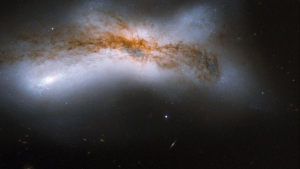
The diversity in galaxy mergers is amazing, and entire careers and catalogs have been dedicated to systems. A favorite pastime for many merger modelers has been trying to figure out what our own galaxy and the Andromeda galaxy will look like as they merge, and trying to figure out which of the mergers we see we might look the most like.
Except, new research, led by Till Sawala finds that the Milky Way and Andromeda may not be destined to become Milkdromeda after all.
Most models of the future merger focus on just the two large galaxies and their motion, but both systems have a small fleet of smaller galaxies in their halos. Of particular note, we have the large and Small Magellanic Clouds in our halo, and Andromeda has the chonky M32 Dwarf galaxy. We also exist in a large group of galaxies that includes the spiral Triangulum galaxy.
And it turns out systems of 3 or more objects like to act out in erratic ways. If you’ve ever read or watched the 3-Body problem, you’ve likely heard that there is no easy mathematical solution and in many cases, 3 objects orbiting one another will eventually become 2 objects and a castaway.
In astronomy, three is one of the hardest numbers, at least in kinematic problems.
If we had a perfect understanding of the exact masses, motions, and density distributions of all the galaxies in our group, it might be possible to brute force a pretty accurate understanding of how our systems will evolve and merge over time. The thing is, we don’t have that. We have a very good understanding of how the galaxies are moving toward and away from us, some information on how they are likely moving in the plane of the sky, and rough estimates of mass, and even rougher estimates of density distributions…
So we can’t brute force the calculations.
Instead, this team ran model after model, looking at a variety of different possible values to map out all the different things that could happen given our limited knowledge.
And it turns out that in under 50% of the cases, Milkydromeda is our future,
But in more than half the cases, we get to fly apart thanks to the influence of our good friends, the LMC and Triangulum.
These models also confirm that LMC is most likely going to merge into our galaxy, while Triangulum will ultimately merge into Andromeda.
It is a galaxy-eat-galaxy universe out there… we just need better data to say with certainty who will be eating whom.
